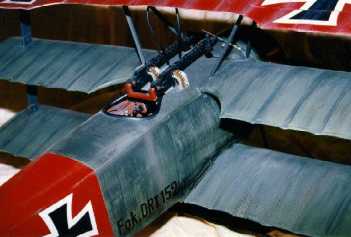Richthofen
by A.E. Ferko
 |
| Fokker Dr 1 152/17; Flown by Rtm. Manfred Von Richthofen, March and
early April 1917. RC model by Dave Millard (DMill83234@aol.com). |
Reviewed by Kerry Nash (rnash@farin.com)
|
Richthofen A Book Review by Kerry Nash I looked at my bookshelf and saw five books
dedicated to Manfred von Richthofen, and I know of at least 20
others. What could justify another retelling of such a well known
tale when so many deserving characters have untold stories? I
have to admit I was quickly engrossed in this new book from Albatros
Productions Ltd. Mr. Ferko covered some heretofore unrevealed
facets to the von Richthofen saga which I had never seen before.
In the end, I determined the coverage of unusual subjects seemed
to lack a real direction and were only told because of their oddity
and not their historical value. There also seemed to be an intentional
lack of objectivity that put the reader and the author in an adversarial
role whose only purpose seemed to be to keep the reader's attention.
Richthofen by A. E. Ferko is an 80-page
soft cover book. There are many outstanding pictures some of which
had never before been published. Artwork by Ray. Rimell highlights
the book in three pages of color plates, as is typical of the
offerings by Albatros Productions. These fine plates show a good
selection of aircraft flown by Manfred von Richthofen. The book
is overpriced at 21 pounds (about $35.00), but part of the problem
here is a poor exchange rate between the U.S. dollar and the British
pound.
Although Ferko writes the book in a conventional
narrative style, at times he tries to cover the more uncommon
aspects of von Richthofen's war years. One of the best examples
of this is a section covering a dispute von Richthofen (as Jagdgeschwader
I Commander) had with an officer at Air Headquarters. Apparently
a Hauptmann Bufe believed that the squadrons should be deployed
so as to form an "impenetrable front", much like a static
trench line. Von Richthofen thought this was implausible and favored
a more fluid deployment of air assets. As it turns out, von Richthofen
was right and his theories are still discussed today at the Air
Force's Air War College. Incredibly Ferko contends von Richthofen
was out of line and should not have questioned an officer at Headquarters.
Ferko attributes von Richthofen's actions as aristocratic snobbery,
and when von Richthofen appeals to senior officers and his tactics
are seen as the correct ones, Ferko simply accuses von Richthofen
as being a superior politician and not a revolutionary tactician.
Apparently Mr. Ferko has no concept of
what a commanding officer's duties are. Manfred von Richthofen
and all commanders have a duty to their troops and country. They
must employ every strategy that would accomplish the goals that
are required. Ferko also contends that taking a disagreement with
another officer to their superiors was an act of Prussian aristocratic
snobbery. Indeed, Ferko is forgetting that the unquestioning adherence
to the orders of a superior is what got the German officer corps
in so much trouble during the Nuremberg trials in the second war.
Anyone with basic knowledge of the military, from Julius Caesar
to Colin Powell, must realize that every officer who desires to
have a successful career must be part politician. If Mr. Ferko
believes an officer should not question orders or use political
savvy to achieve legitimate goals, he would probably do best if he
limited his writing to children's books or fantasy.
I find it hard to believe that Ferko is
so naive that he does not understand the role of a commanding
officer. Instead, I believe the author took positions as he did
so to create new controversy on an overdone topic. Unfortunately,
his attempts appear sophomoric. These attempts at creating new
facets on an old diamond fail. In my opinion the best (or worst)
example of this occurs when Mr. Ferko writes the inevitable chapter
on "Who Killed the Red Baron?". He devotes the majority
of his text on the premise that Manfred von Richthofen was killed
by Australian infantry after he made a forced landing due to engine
damage. Ferko makes some questionable interpretations of some
first-hand reports, but provides us with no real proof. Considering
that von Richthofen's Fokker Triplane engine is at the Imperial
War museum the least he could have done is show us the engine damage.
It seems a shame that tabloid fiction is returning to World War
I aviation literature (and not even at pulp prices). If your main interest is in Manfred von Richthofen, you may want this book for the many fine pictures or the color plates. However, if your interest is in historical World War I aviation you may want to pass on this book. © 1997 Kerry Nash - All rights reserved |
